Matador Network's Blog, page 542
January 14, 2022
Gorgeous Tennessee Airbnbs across the state for your next Southern roadtrip

Tennessee is the home of country music and whiskey. The barbeque is incredible and music sensations including Dolly Parton, Elvis Presley, B.B. King, and more called the state home. Tennessee is also home to many popular locations like Memphis, Chattanooga, and Nashville (see our guide to Nashville Airbnbs). Visiting Tennessee, one can experience the nightlife of Nashville and the trails and outdoor activities in the Tennessee Hills. No matter when or why you’re going here are the most stunning Tennessee Airbnbs for your next getaway.
The best Memphis, Tennessee AirbnbsThe best Chattanooga, Tennessee AirbnbsThe best Nashville, Tennessee AirbnbsAirbnbs in the Tennessee hillsAirbnbs near the Jack Daniels distillery
We hope you love the Tennessee Airbnbs we recommend! Just so you know, Matador may collect a small commission from the links on this page if you decide to book a stay. Listed prices are accurate as of the time of publication. See our full Advertiser Disclosure here.
The best Memphis, Tennessee Airbnbs
Newly renovated duplex in Cooper-Young neighborhood

Photo: Airbnb

Photo: Airbnb

Photo: Airbnb

Photo: Airbnb
This duplex is located in the heart of the Cooper-Young neighborhood. The home features a spacious one bedroom with a bathroom and an open spacious living room with a pull-out sleeper couch. The kitchen is newly renovated with modern appliances. The home is close to all of Memphis’ top attractions like Memphis Made Brewery, City Market Grocery Store, Overton Sq., and the Memphis Zoo.
Four guests, one bedroom
Price: $86 per night
Stylishly remodeled home in historic Memphis neighborhood

Photo: Airbnb

Photo: Airbnb

Photo: Airbnb

Photo: Airbnb
This swanky home, commonly known as the Lucky Number Seven, is newly remodeled with a spacious, decorative living room and dining room. Each room is decorated glamorously, just like the city itself — which you’ll experience with easy access to the city center on foot, bike, Uber, or public transit. This one’s built for groups and pets, with a lounge deck for beers and to take in the smell of early-morning bbq.
Ten guests, three bedrooms
Price: $108 per night
Lakefront home with a spacious sun deck and game room

Photo: Airbnb

Photo: Airbnb

Photo: Airbnb

Photo: Airbnb

Photo: Airbnb
Enjoy a waterfront view at this stunning lakefront home in Memphis. This home is a perfect vacation spot for the family or groups of friends, and it features four bedrooms, a fully equipped kitchen, and a spacious living room with gorgeous lake views. There is also a game room for more entertainment and an outdoor patio area perfect for watching sunrises and sunsets or grilling.
Twelve guests, four bedrooms
Price: $500 per night
Sleek and chic home in the Broad Avenue Arts District

Photo: Airbnb

Photo: Airbnb

Photo: Airbnb
Welcome to this contemporary architect-designed three-bedroom home that’s perfect for a family or group gathering. The home theme is sleek and stylish with its spacious living room with surround sound and a big projector screen for watching movies. The open and big kitchen and dining area is great for cooking meals with friends and family, but if going out is more your style the home is within walking distance to local shops, restaurants, and breweries — as well as the legendary Memphis music scene.
Twelve guests, four bedrooms
Price: $98 per night
The best Chattanooga, Tenneesee Airbnbs
Cozy and remote tiny home at the foot of Lookout Mountain
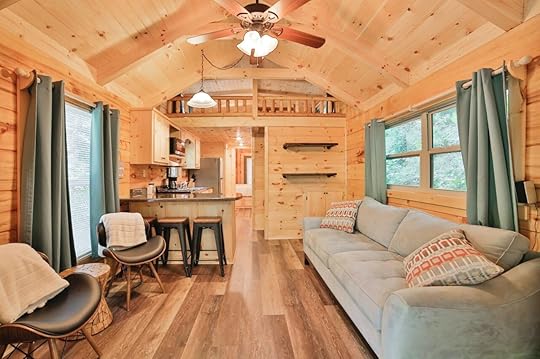
Photo: Airbnb
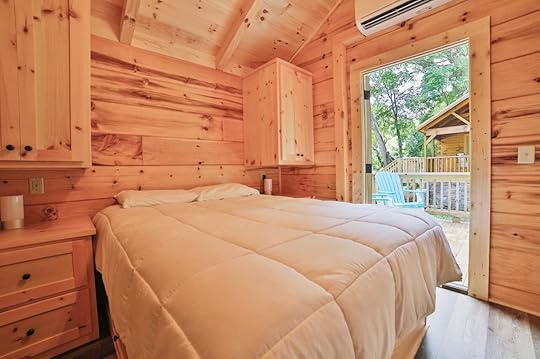
Photo: Airbnb

Photo: Airbnb

Photo: Airbnb
Do you want to go off-grid for a bit? This secluded cabin is a tiny home great for the ideal couples gateway. The open floor plan features a living room, fully equipped kitchen and in the back of the house is the master bedroom that leads to the private hot tub. There are also two twin beds lofted at the top of the cabin, and in the back of the home is a spacious screened-in porch with a seating area to sit and have a cup of coffee. The house is just one mile from South Broad and Ruby Falls.
Four guests, one bedroom
Price: $119 per night
Modern townhouse in the center of Downtown Chattanooga

Photo: Airbnb

Photo: Airbnb

Photo: Airbnb

Photo: Airbnb
This townhouse is in the heart of downtown Chattanooga. The home has many modern finishes and a full chef’s kitchen, along with an open living room that brings in much light. The house is across the street from a public park, so if the kids want more space to play, they can head to the playground. The home is also close to all of downtown Chattanooga’s amenities and a mile away from Free Shuttle Bus, a free method of transportation for tourists to get around downtown.
Eight guests, four bedrooms
Price: $102 per night
Bohemian sunroom suite near Signal Mountain

Photo: Airbnb

Photo: Airbnb

Photo: Airbnb
Welcome to this cozy bohemian gateway located at the foot of Signal Mountain. This cozy hideaway features vaulted ceilings and panoramic windows that will genuinely immerse guests into the mountains. There is a wooden patio with a seating area and a hot tub. The home is near Chattanooga’s best hiking trails like Signal Point, Rainbow Lake, and Falling Water Falls.
Two guests, one bedroom
Price: $145 per night

Photo: Airbnb

Photo: Airbnb

Photo: Airbnb
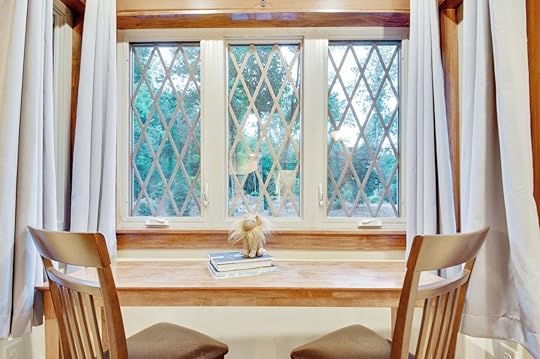
Photo: Airbnb
You’re truly walking into a storybook when staying at the Tudor cottage. This quaint cottage nestled at the Tennessee Gorge just minutes from Downtown Chattanooga. Guests will have access to 15 acres of land and a beautiful view of the Tennessee River right across the street. There are also other gardens, lawns, and trails that the guests can check out around the property.
Four guests, one bedroom
Price: $180 per night
The best Tennessee Airbnbs in Music City

Photo: Airbnb

Photo: Airbnb

Photo: Airbnb

Photo: Airbnb
Centrally located luxury townhouse with resort-style amenitiesThis luxury four-bedroom townhouse is packed with all the amenities needed for your Tennessee getaway. This townhouse has three floors with spacious bedrooms located on each floor. On the second floor is an open floor plan with the living room and kitchen. The townhouse is within walking distance to West End activities and less than 3 miles to Broadway.
Twelve guests, four bedrooms
Price: $499 per night
Whimsical tiny house cottage in the city’s Design District

Photo: Airbnb

Photo: Airbnb

Photo: Airbnb

Photo: Airbnb
Come and stay at Tennessee’s most wish-listed Airbnb. This romantic and dreamy tiny home is ideal for couples or singles gateway. The cottage is modern but still has its vintage charm and touches that transport guests back in time. There is a kitchenette, living area, and the bed is lofted at the top of the home. There is an outdoor porch area where guests can sit and enjoy what nature offers.
Four guests, one bedroom
Price: $100 per night
Nashville’s pink sanctuary

Photo: Airbnb

Photo: Airbnb

Photo: Airbnb

Photo: Airbnb

Photo: Airbnb
Another glamorous stay for the ladies and gents who are into all things pink. This pink sanctuary has everything decorated with the color pink. The cabinets in the full kitchen are pink, as well as the dining chairs, and the living room area is decked out in the color pink, and the home itself is even pink. There is an outdoor patio with a BBQ area and a movie theater area with a projector and movie seating.
Four guests, one bedroom
Price: $452 per night
Airbnbs in the Tennessee hills
Historic Stone Cellar

Photo: Airbnb

Photo: Airbnb

Photo: Airbnb

Photo: Airbnb
Stay at one of Tennessee’s oldest and most historic buildings for your next southern getaway. The Stone Cellar Suite is in the oldest town in Tennessee. There is a private entry to get into the historic home under the building. The home has an open floor plan with a bedroom area and a small kitchen. The home was formerly a boarding house for Jonesborough’s first female college and has now turned into a quaint historic home for guests.
Two guests, one bedroom
Price: $149 per night
Luxury mountain escape near Appalachian Trail

Photo: Airbnb

Photo: Airbnb
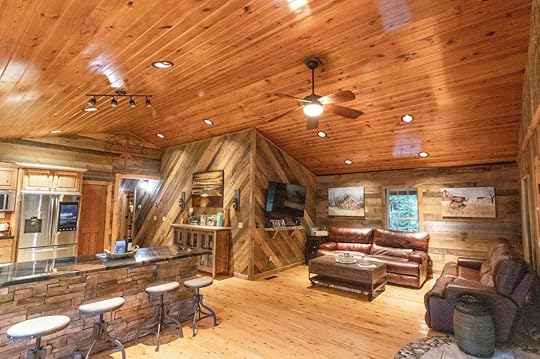
Photo: Airbnb

Photo: Airbnb
This luxury home offers the perfect amount of seclusion that one needs for a quick gateway. The home is filled with luxury amenities, two large porches, a fire pit, and a seating area outside. Guests can also sit and relax outside with the noise of a small waterfall as soothing background noise and other spa amenities include a massage chair and also a jacuzzi bathtub. If you prefer relaxing outside, the Application Trail is nearby as well as other outdoor activities.
Six guests, three bedrooms
Price: $149 per night
Airbnbs near the Jack Daniels distillery
Homey two-bedroom cabin near Tom Lake
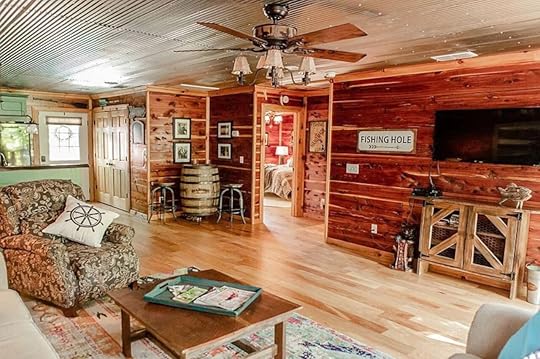
Photo: Airbnb

Photo: Airbnb

Photo: Airbnb
Located near Tom Ford Lake is this cozy two-bedroom cabin. The cabin features a spacious living room and kitchen. There is also a wrap-around tree deck and a fire pit outside with a seating area perfect for roasting marshmallows or hanging out by the fire. The home is twelve miles from the Jack Daniels distillery and only 1/2 mile from Holiday Landing Marina & Blue Gill Restaurant.
Four guests, two bedrooms
Price: $130 per night
Lakeside retreat in small private neighborhood

Photo: Airbnb

Photo: Airbnb

Photo: Airbnb

Photo: Airbnb
Here’s another lake-side retreat for your Tennessee vacation. This new stunning lake build has two floors. On the first floor is the spacious kitchen and living room, the master bedroom, and a full patio with a fireplace and outdoor seating, and the second floor has two other huge bedrooms with queen and king-sized beds. The home is just a 15-minute drive to other shops and restaurants, and the Jack Daniels distillery. 
Eight guests, four bedrooms
Price: $265 per night
A therapist’s guide to best mindful health retreats in the US this year

The last few years of pandemic have heaped on new stresses but also built our resiliency, and more and more of us are seeking wellness. We’re looking to not just lose weight and gain healthy habits, but to also holistically heal and grow. Luckily, health retreats are going over and above to keep up with our needs. Today, mindfulness is at the core of most health movements, allowing for a stunning array of traditional and unexpected retreat options that fit any interest or comfort level.
Mindfulness, although often connected with yoga, meditation, and therapy, is the act of being fully present in a moment and observing rather than reacting. Most of us are woefully out of practice but anyone can do it. And evidence continues to point to the connection between mindfulness and a healthier, more satisfying experience.
Since most of us struggle with turning off our brains’ reactionary commentary, mindfulness is best reached through our senses. Anything that involves sensory immersion can help us be more connected with ourselves in the world around us and ultimately our health, which means there is something for everyone with these 2022 health retreats around the United States.
Yoga retreats
Photo: Wanderlust/Facebook
Yoga builds mind and body connective health through fluid movement and meditative practices. Yoga classes and workshops are everywhere, one of the most common types of health retreat. But large festivals can add community, variety, and commitment.
Telluride Yoga Festival — ColoradoThis June, the annual Telluride Yoga Festival offers over 100 events at the village-style campus in Colorado’s Rocky Mountains. The four-day event pulls together world-recognized teachers for yoga, meditation, fitness, climbing, and wellness courses. Past attendees rave about the intimate setting and collective feel.
Wanderlust — Taos, New MexicoFor those needing more flexibility on their calendar, Wanderlust hosts events and festivals around the country and world throughout the year. The events kick off just after the new year with Winterlust in Taos, New Mexico.
Sound bathing retreats
Photo: Menla/Facebook
Sound bathing encourages us to focus on strategic sounds in an otherwise still environment. Leaders combine tonal instruments like singing bowls, gongs, and tuning forks with percussive instruments and vocal techniques. Proponents of sound bathing believe strategic sounds can affect vibrational energies and brainwaves frequencies, reducing stress and pain.
Menla, New YorkMenla, part of the Dalai Lama’s non-profit cultural Tibet House, is offering a fun and intimate sound, yoga, and meditation retreat this February. The three-day retreat promises a nurturing environment for all experience levels and free time to explore the surrounding Catskills.
Then, in June, Menla hosts the 11th Annual Sound Healing Retreat with the Sage Academy of Sound. Internationally known faculty members will teach medicinal songs, ancestral instruments, and daily yoga sessions. The four-day retreat includes lodging and camping options.
Detox wellness retreats
Photo: GaudiLab/Shutterstock
Toxic was the Oxford Dictionary’s word of the year in 2018, a nod to our desire to rid ourselves of all the harmful influences in our lives. The good news is most wellness and health retreats detox through healthy eating, locking away devices, laying off the alcohol, and engaging in activities to cleanse the body. If you want to take it further, consider these detox deep dives.
Heart of a Warrior Retreat — Forestburg, TexasCamp Detox’s four-day Heart of a Warrior Retreat is looking for 10 ready-to-work participants in late August. This Forestburg, Texas retreat includes classic detox activities and therapeutic introspection to explore personal vices and our cultural obsession with busyness. This retreat aims to help people be at peace with themselves.
Art of Living Retreat Center — Boone, North CarolinaOr go quiet with a silent retreat at the Art of Living Retreat Center in Boone, North Carolina. The introductory Stepping into Silence is a four-day retreat offered throughout the year. Learn techniques to calm the mind for two days and then enter a silent period after dinner on day two. Benefits include deeper sleep, reduced stress, new cells in the hippocampus, and improved focus.
Forest bathing retreats
Photo: Lodge At Woodloch/Facebook
Have no fear if you’re not an outdoor adventurer. Forest bathing is a sensory immersion practice from Japan. Instead of hiking with a destination in mind, “bathers” mindfully take in all the smells, sights, sounds, and tastes of the forest. Research reports reductions in blood pressure and stress hormones in addition to perceived calmness.
The Lodge at Woodloch — Poconos, PennsylvaniaThe Lodge at Woodloch in the Poconos features a range of wellness options but uniquely offers private forest bathing with their naturalist, a certified Nature Therapy guide. Other mindful experiences include nocturnal walks, eagle viewing, tea rituals, and foraging with an herbalist. This award-winning destination spa is all-inclusive with gourmet meals and 500 acres to roam.
Kripalu Center for Yoga and Health — Stockbridge, MassachusettsIf you’re looking for an intensive group experience, the Kripalu Center for Yoga and Health is hosting a mindful outdoor guide leadership course in late April. You’ll spend eight days in Massachusetts exploring forest bathing, outdoor skills, yoga, Ayurveda, and research on the benefits of nature.
Culinary and nutrition retreats
Photo: Blackberry Farm/Facebook
Mindful tasting is a common technique when teaching mindfulness in therapy. Participants slowly experience the texture, smell, and taste of a single piece of candy or fruit. Mindful eating as a daily practice helps us connect with our food’s quality, quantity, and food choices.
Cook Academy — Essex Junction, VermontThe personalized nutrition education that many retreats offer is beneficial. But it often doesn’t engage participants in mindful practices that change our relationships with food. Instead, look for a retreat that gets you in the kitchen. The Essex Resort in Vermont houses the Cook Academy. Whether cooking, baking, or rolling sushi, these classes cover almost every theme you can imagine. Snag the gourmet getaway for access and make the stay complete.
Blackberry Farm — Walland, TennesseeThe famous Blackberry Farm in Tennessee covers the entire range of the culinary experience. Guests can garden and do artisanal cooking with the Farmstead Field School and then join various tasting experiences and cooking demonstrations. Other wellness options include Nourishing Table healthy eating classes, forest bathing, spa treatments, and outdoor activities.
Creative retreats
Photo: Elemental Arts/Facebook
While it may not be the most obvious of health retreats, creating art, regardless of skill, consistently lowers cortisol, releases dopamine, and reduces cognitive decline. Art-making creates the mindful “flow state” that activates a different part of the brain than other thinking patterns.
Mandalas art classes — Across the USMandalas, or repeating geometric patterns, are examples of ancient art and meditative practice from multiple religions that originated in Asia. Today they’re also used in coloring and sand art self-soothing techniques. Two-day workshops around the country help participants create and process a personal mandala.
Elemental Team Arts — San Francisco, CaliforniaSome artists worldwide are going back to the ancient practice of sand mandalas, raking massive designs into beaches. They report getting lost in the meditative trance of creation, and a strange satisfaction as the waves erase it clean. Many offer lessons on Airbnb experiences, but Elemental Team Arts in San Francisco offer monthly public workshops to help make a gorgeous sand creation.
If you’re not into mandalas, the creative retreat world is full of painting, calligraphy, knitting, woodworking, and other mediums that help bring on a “flow state.”
Mindful fitness retreats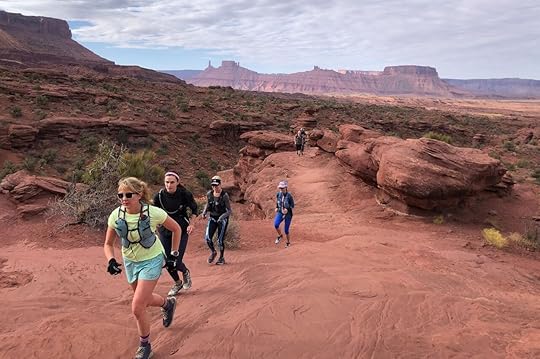
Photo: Run Wild Retreats/Facebook
If you’re anything like me, you benefit from turning up your tunes and pounding out a workout. But mindful exercise involves paying attention to your body before the pain starts. If you find yourself battling exercise, look to mindful fitness retreats to connect with movement.
Wanderlust — Across the US and international locationsThe simple act of paying deep attention to our steps as we walk is an ancient meditative practice. Kick it up a notch with the Run Wild Retreats for women. These worldwide retreats are typically four to seven days and fit three different fitness levels. Participants immerse themselves and build confidence.
SUP, Surf, and Zen — Cocoa Beach, FloridaSurfing also demands mindfulness to learn, making it a popular pairing with yoga and beachy vibes. Join the year-round, four-day SUP, Surf, and Zen retreats at the Full Circle Yoga School in Cocoa Beach, Florida. 
What is an orgasm workshop

Orgasms have been shown to reduce stress and increase self-esteem — all while triggering a rush of the pleasure hormone oxytocin throughout the body. And yet, not everyone is getting them equally. According to a study of over 52,000 American adults, straight men usually or always orgasm 95 percent of the time they have sex, compared to 65 percent for hetero women. This is what’s known as the orgasm gap, and it’s a problem. Why? Because sex builds intimacy and brings physical happiness — so if one half isn’t enjoying it as much as the other, then there’s something wrong. The gap doesn’t just apply to couples, either: Another study revealed only one in four women masturbates regularly, which is half the rate of men. This is where a female masturbation class can help.
Although men reach orgasm more frequently than women, it would be a mistake to think this is something that only affects those with vaginas. So many things can stand in the way of sexual fulfillment, including low self-esteem, past trauma, and poor communication. Meanwhile, pop culture tells us all kinds of misinformation about sex and places too much emphasis on the orgasm itself. This makes pleasure too goal-oriented, which, ironically, decreases fulfillment and desire.
Orgasm workshops are designed to help primarily women, but also couples, solo men, and members of the LGBTQ+ community overcome these issues. They focus on building confidence by helping people understand they don’t have to fit into a single model of desire. They also give people permission to enjoy what they find pleasurable — rather than what culture tells them they should be a turn-on. So, now you know what an orgasm workshop is, here’s where you can find one.
1. OMGyes — OnlineDon’t fancy attending a female masturbation class IRL? This one’s for you. The website — which recently rose to fame after actress and feminist icon Emma Watson revealed she was a paying subscriber — has combined the experiences of more than 2,000 cisgender women, aged 18 to 95, to create a science-based guide to female pleasure. So forget everything you read in Cosmo as a teen: This is previously unpublished information gathered from real women from around the world. Membership requires a one-time payment of around $63, and for that you get access to 62 videos, as well as 11 “touchable” guides that allow you (or your partner) to practice techniques on the screen for a more hands-on approach.
2. Intimacy Matters — London, UKColin Richards, a trained sex and relationship therapist, created Intimacy Matters in 2005. His organization now runs an enormous range of mentoring sessions and workshops ranging from one-on-one private tutoring with vetted volunteers to group events for people of all orientations. Couples’ workshops cost around $193 and cover things like erogenous areas, prostate massage, and edging. Aside from running hands-on, nude orgasm classes, Colin is a vocal advocate for physical and mental health. He believes a good sex life is essential to overall wellbeing and should be discussed openly and honestly.
3. Secret Yoga Club — Worldwide (but primarily London, UK)Secret Yoga Club events blend sex education with a range of creative activities, including art and dance. Every workshop and retreat is slightly different, but attendees are usually encouraged to discuss their sexual history in a supportive group setting. You’ll also learn about communication, arousal, and things that get in the way of pleasure, such as negative self-talk. Sessions are fully clothed and hands-off, but “homework” is encouraged. London-based events range from $32 to $322 for admission whereas the international retreats start from $1159 and include food and accommodation.
4. Bodysex — Manhattan, USBetty Dodson became active in the sex-positive movement in the late 1960s and has been recently named one of the top 10 sexual revolutionaries by Cosmopolitan and number 43 of the 100 most important people in sex by . In 2007, she launched her business with partner Carlin Ross to promote the “Betty Dodson” method of self-love, which involves a Hitachi Magic Wand vibrator and a towel. In addition to hosting an array of videos and tutorials on their site, the duo hold biannual two-day Bodysex workshops held at Betty’s apartment in midtown Manhattan. Each nude event is designed to teach cis and transgender women learn to overcome negative body image and pleasure anxiety. Bodysex is a registered charity, but the suggested donation is $1,200.
5. The V. Club — New York, USThe V. Club is a little different to most orgasm workshops in that classes place just as much empahsis on the psychological side of sex as the physical. Run by Courtney Cleman, a New York-based relationship coach, sex and relationship expert, and Kate Lubimov, a globally renowned sex educator, the organization offers women of all ages and orientations nudity-free classes on pleasure and arousal techniques. Speaking to Bustle, Cleman says, “Most therapy and workshops on sex and relationships focus on men’s or couple’s needs. We created a class to teach what every woman should know about getting the most satisfaction but usually doesn’t, which is why so many women struggle with achieving orgasms easily and consistently as compared to men.” Seminars run for four hours and are priced at $40 an hour.
6. O.School — OnlineAnother one for people who aren’t keen on the in-person approach, O.School is a live-streaming platform anyone can watch. It features sex ed classes from some of the most well-respected educators in the business who discuss everything from pegging and porn to masturbation and communication. Workshops are completely free (although participants have an option to tip) and viewers can jump in to ask questions live. In addition to streamed classes, visitors can also read news, trending topics, and cheat sheets written by coaches and doctors. Check the schedule for upcoming streams and mark your calendar for classes that look interesting.
7. Orgasmic! A Guide to Female Pleasure — London, UKSh!, a London-based sex toy emporium, hosts events covering everthing from bondage to dirty talk. It’s monthly Orgasmic! A Guide To Female Pleasure event is a fully-clothed female masturbation class, all about clitorises and climaxing. Attendees will be taken on a tour of orgasmic delights, including how to locate the elusive G-spot, plus tips on techniques and toys. Tickets cost around $45, and for that you’ll get refreshments (usually bubbly and nibbles) and a one-and-a-half-hour class that includes a talk and a Q&A session, followed by mingling and and shopping discounts.
8. Tantra is Love — Sydney, AustraliaThis Sydney-based team hosts a range of events ranging from yoga to self-love classes, but it’s the tantric workshop that focuses specifically on sex. Over the course of two days, attendees learn about different techniques, including how to improve communication and intimacy, how to last longer and how to have different types of orgasm. Classes are mixed gender and LGBTQ+ friendly, and there’s no nudity or genital touching. You’ll be given a workbook full of tips and information for you to try out in the privacy of your own home.
9. Sexpert Consultants — Washington, USSexpert Consultants run a selection of private evens, group classes and online workshops covering a range of sex-related topics, from fellatio and cunnilingis to kink and cannasexuality (that’s sex on cannabis). Their popular ‘Women’s Sensual Self-Care’ female masturbation class is the one to choose if you want to learn how to incorporate more sensuality into your self-care routine. You’ll also pick up some tips on how to prioritize pleasure and figure out what sparks your desire. While it’s not specifically focused on orgasms, you do get a goodie bag filled with treats — including a bullet vibrator — to try out at home. The class costs $50 and is fully clothed, with no intimate touching. There’s also the option to take an online version if you’re feeling shy. 
January 13, 2022
Vegans-only travel? Trip company tempts curious travelers with $500 off Europe vegan tours

When thinking about the food of Eastern Europe, it’s easy to think first and foremost of meat. It’s the land of wiener schnitzel and seemingly endless varieties of German sausage, after all. But a newly discounted group tour is looking to highlight the plant-based side of the region.
Contiki, a tour provider for 18 to 35 year olds, is offering $500 off its eight-day Vegan Food Europe Explorer tour. The trip will have travelers — both vegan and non-vegan are welcome, of course, but vegan food is the only thing on the menu — visiting vegan spots in cities across Eastern Europe this summer. It’s led by the vegan expert and zero waste activist Clare Every of @thelittelondonvegan.
Berlin (often ranked among the most vegan-friendly cities in the world), Prague, Vienna, and Budapest are all on the list. Bike tours through Prague are on the itinerary, as are beers in Berlin, cooking classes, and Budapest’s famous natural thermal pools (eating isn’t the only thing you can do while traveling, even on a vegan food trip). In-destination transportation, meals, and hotels (including stays at Moxy Berlin and A&O Budapest) are all included. The whole experience ends at the Vegan Summer Festival, which is one of the largest vegan festivals in Berlin.
As to why? A contact working with Contiki noted that, by some measures, veganism has increased 500 percent in the United States over the last seven years to go from 1 percent of people to 6 percent. Whether it’s for environmental reasons, health reasons, or animal welfare reasons, there’s no denying that there’s more conversation around plant-based eating now than in years past.
The new vegan trip isn’t the only new Contiki initiative of the new year. The company announced that, starting Jan. 1, 2022, Contiki is 100 percent carbon neutral.
If this all sounds up your alley, the Eastern Europe vegan trips start at $1,634 with financing from $146 per month after the more than $500 discount through January. Details can be found on Contiki’s Europe Vegan Food Tour page.
MAPPED: Everywhere to stop along the world’s longest train journey

The world’s longest train route isn’t the famous Trans-Siberian Express or “The Canadian” east-to-west long-hauler: it’s a little-known route from Singapore to Lagos, Portugal. It crosses the entirety of two continents, covers 11,653 miles, and costs around $1,300 to travel the entire route.

Photo: htGoSEVe/Reddit.com
The route is completely doable, but it’s not an official route operated by a single train service. It was first shared on a page for map aficionados on Reddit, where a user shared a map of the route only available as of mid-December 2021. The original poster has since made a few changes to the recommended route, but the overall journey is completely possible (though a few trains are currently on hold due to COVID closures). The proposed route includes a stint on the Tran-Siberian Express before taking the northern route through Europe, passing through Belarus and Poland before hitting Berlin, Paris, northern Spain, and, eventually, Lagos.
It may be the best sightseeing trip in the world.
Though it’d take roughly 21 days without any stops, you’ll definitely want to make as many stops as possible. The route goes through the jungles of Malaysia, passes the Great Wall of China, crosses the Mongolian Desert to Lake Baikal, runs the length of Russia to Moscow, and passes castles and wine regions in Europe. The final leg is a stunning ride with coastal views in western Portugal. If you’ve got time to make quite a few stops, you’ll be able to see some of the world’s most beautiful natural, historical, and famous sights. If you’re ready to hop aboard the world’s longest train trip, here are the sights you absolutely cannot miss.
Perhentian Islands, Malaysia
Photo: Izuddin Helmi/Shutterstock
After spending as much time as possible in Singapore, hop aboard and make plans to stop near Narathiwat, in central Malaysia. From there, you’ll want to get to the Perhentian Islands. They’re the picture-perfect definition of a Southeast Asian island, with everything from luxury resorts to backpacker hostels. Activities on offer range from hiking to snorkeling with sea turtles and cycling around the islands to try Nasi lemak, a tasty dish best served by local food carts on the side of the road.
The Terracotta Army, China
Photo: costas anton dumitrescu/Shutterstock
The discovery of the Terracotta Army in 1974 took the archaeological world by storm. Under the orders of the first emperor of China, workers built more than 8,000 warrior sculptures and 500 horses and chariots. The warriors have unique faces, suggesting that it wasn’t an assembly-line process, but rather, a decades-long effort to recreate the military might needed to protect Emperor Qin Shi Huang after death.
The Great Wall of China, China
Photo: aphotostory/Shutterstock
The Great Wall of China is more than13,000 miles long and the biggest human-made building in the world. Jump off for a few days in Beijing to see it, as well as the Forbidden City. It was home to 24 emperors across 500 years. It’s now a UNESCO World Heritage Site and potentially the most culturally and politically significant structure in all of mainland Asia.
Ulaanbaatar, Mongolia
Photo: Alexandru Nika/Shutterstock
Break out the puffy jacket and de-board in Ulaanbaatar, one of the most unexpected places to stop on the world’s longest train trip. Plan to spend a few days with nomadic peoples in the desert around the capital city, where activities like falconry, sleeping in gers (cold-weather nomadic tents), horseback riding, and visiting the Gobi Desert are on the agenda.
Lake Baikal, Russia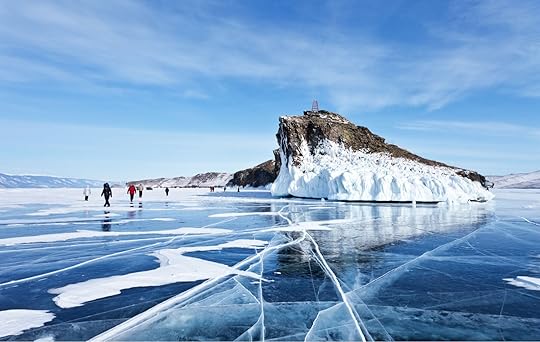
Photo: Katvic/Shutterstock
Lake Baikal is the world’s deepest lake at 5,700 feet. According to UNESCO, it’s the “Galapagos of Russia” owing to its fantastic diversity and landscapes. Stay in Irkutsk and spend a few days on wildlife tours, hiking, or hitting hot springs and frozen lakes before continuing your trip.
Moscow, Russia
Photo: Baturina Yuliya/Shutterstock
Plenty of Moscow‘s famous buildings are among the most gorgeous and unique in the world, but you’ll want to be sure there are some specific buildings you don’t miss. Jump off for a few days to visit Red Square and the Kremlin, the physical and symbolic heart of the city. St. Basil’s Cathedral looks like it belongs at Disney World, and the Bolshoi Theatre is possibly the world’s most famous opera house. Catch a show even if you have no idea what they’re saying.
Belovezhskaya Pushcha National Park, Belarus
Photo: Ruslan Kalnitsky/Shutterstock
Take a northern European safari in Belarus. Belovezhskaya Pushcha National Park is home to wild bison, boars, elk, lynx, wolves, beavers, and hundreds of other rare species that thrive in the densely forested park. It’s west of Minsk, on the border with Poland.
Warsaw’s WWII Sites, Poland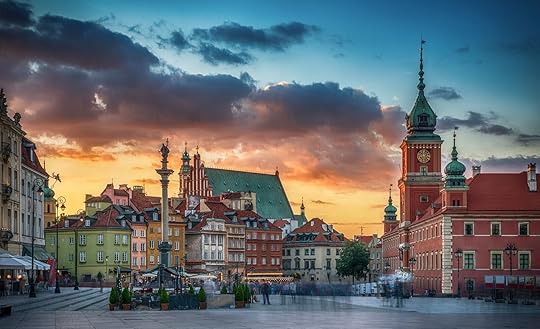
Photo: Triff/Shutterstock
Give yourself a break from the world’s longest train rides for a few days in Poland, where you can spend a few days experiencing the tragedy and beauty of the country. Though somber, sights like Oskar Schindler’s factory and the Auschwitz WWII Concentration Camp (near Krakow) are must-visits, telling the often untold stories of the horrors of World War II. But Warsaw is full of beauty and color, too. Walk the grounds of the fairytale-like Lazienki Park, trek to Tatra National Park (equally as beautiful as Glacier National Park), stroll the markets at the colorful Old Town Market Place, or frolic in the magical “crooked forest.”
Berlin, Germany
Photo: PHOTOCREO Michal Bednarek/Shutterstock
Germany doesn’t skimp on museums, shopping, or fantastic bars and late-night clubs (including some very unique options), but Berlin especially has fantastic traditional food. Visit beer halls, take a food tour, search for the best German pretzel, or wander through one of dozens of food markets and outdoor fairs. Head out on a day trip to Dresden (about two hours away) for fantastic architecture and amazing parks and museums.
Neuschwanstein Castle, Germany
Photo: Naumenko Aleksandr/Shutterstock
If you have time to make the roughly four-hour drive from Frankfurt for an overnight trip, visit the beautiful Neuschwanstein Castle. It’s one of the most famous in Europe (perhaps the most famous) and is said to have inspired Walt Disney’s designs for castles at his theme parks. Other good day trips include the colorful medieval town of Rothenburg ob der Tauber and hiking trips to the Black Forest — the setting for many a Grimm Brothers fairytale.
Paris, France
Photo: Stockkbym/Shutterstock
Aside from the obvious sights and museums in Paris, which need not even be listed, sights to see near Paris include Versailles and Chantilly Castle. High-speed trains from Paris can connect you with other cute towns in France like Lyon or Dijon, and you’ll find plenty of cycle or drive tours leaving from Paris to explore the French countryside for a night or two.
Bordeaux Wine Country, France
Photo: artem evdokimov /Shutterstock
If you like wine, the best stop off the world’s longest train trip will certainly be Bordeaux, famous for its wines of the same name. There are more than 6,000 wineries in and around Bordeaux, so options range from day trips to pairing dinners to stays at wineries and even wine-and-hike tours. The towns in the region have all manner of hotels and inns, fantastic restaurants, charming stores and museums, and even fantastic beaches such as those Lac de Chalain, which look straight out of the Caribbean.
The Guggenheim Museum, Spain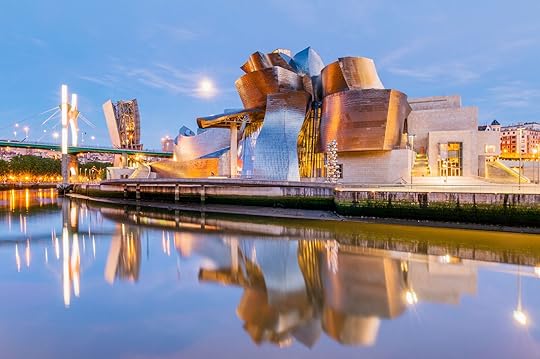
Photo: Rudy Mareel/Shutterstock
You can’t make a wrong choice for what to see in Bilbao, though the Guggenheim Museum is a great place to start. You’ll also want to stroll through Casco Viejo and the famous La Ribiera Market. You can rock climb or surf just north of the city or head to the Pyrenees for hiking, mountain biking, or skiing outside of town. You’ll also be fairly close to Pamplona, so visit in mid-July if you’re dreaming of running with the bulls.
Cascais, Portugal
Photo: Ricardo Mateus/Shutterstock
Lisbon is close to the final stop for the world’s longest train trip, so it’s one of your last opportunities to get out and explore. While you may want to head north to the seaside town of Porto, Cascais is the place to go for a few days of old-school European glamour. The beachside town is colorful and full of fresh seafood restaurants and historic, if expensive, hotels. It’s not quite as popular (yet) as other seaside towns in Portugal, so go before it starts feeling like the latest Instagram hot-spot.
Lagos, Portugal
Photo: Smileus/Shutterstock
The world’s longest train route ends in Lagos, which is a small and beautiful beach town. Give yourself at least a few days here to relax before wrapping up your epic trip. You can’t go wrong with any beach in town, but the blue water, sea caves, and rock formations at Ponta da Piedade make it probably the most famous. 
You can win $10,000 toward a workation at any destination you choose

Remote work doesn’t mean you have to stay home, seated at your kitchen in your pjs while eating cold Pop-Tarts straight out of the package. Remote work means that you can take your pjs, your sugary treats, and your laptop to work from anywhere in the world.
Online travel agency KAYAK knows some of us need a little push to leave the kitchen table behind and take a workation, so it’s giving one remote worker an expenses-paid trip up to $10,000 to work from anywhere in the world. To enter to win the Roam Remotely Sweepstakes, all you need to do is to fill in your info (first name, last name, email address, and country of residence) on the contest’s webpage.
The $10,000 grand prize will be delivered in the form of four $2,500 AMEX cards, so you get to pick where you want to take your workation and spend all that dough. Need inspiration? We at Matador Network recommend that you take a good look at our 2022 travel recommendations. From Saudi Arabia, to French Polynesia and the Azores Islands, we have selected some of the coolest places where you can take your laptop and make the most of your work flexibility this year.
The contest closes on Friday, February 4 at 11:59 AM EST, and the winner will be announced on Monday, February 7. Only US residents 18 years or older are eligible to enter KAYAK’s Roam Remotely Sweepstakes.
And if you don’t win the grand prize, don’t despair. There are tons of places around the world that have created special digital nomad visas to make life super easy for remote workers. You won’t get a $10,000 to pay for your trip, but you’ll still get the chance to work from amazing destinations like Costa Rica, Iceland, or Mauritius. 
I went on my first-ever cruise during Omicron. Here is how it went.

There are two types of people in this world: Those who go on cruises, and those who feel like if they went their entire lives without going on one, they would probably be fine. I used to be firmly in the latter camp until I got the chance to experience a short voyage on Royal Caribbean’s Navigator of the Seas. Though I was skeptical about taking a cruise during Omicron, we were assured of the safety measures in place ahead of our trip and that put me at ease.
The vacation vibes were here, and so was every possible COVID-19 safety procedure
Photo: Author
From the moment we boarded the thousand-foot-long vessel, which set sail out of the Port of Long Beach just outside Los Angeles, we could feel the vacation atmosphere in the air. I’d always imagined that if you were going on a cruise, it had to be out of Miami with a tropical destination somewhere in the Caribbean, but even on the Pacific Coast, the island vibes were clearly present and accounted for. Especially on the ship’s deck with a live steel drum band and The Lime & Coconut bar where I had my fair share of margaritas.

Photo: Author
The outdoor deck was the only area where masks weren’t required, although there were some unmasked areas inside which were designated for vaccinated passengers only. We had to show proof of vaccination and a recent negative COVID-19 test to get on board, so it was mainly just children who were unvaccinated. During the pandemic, Royal Caribbean has been limiting the number of passengers for each trip, judging voyage by voyage what capacity they feel comfortable taking out to sea.
Though there were hand sanitizers everywhere and hand-washing stations were a mandatory part of entering the main dining areas, I still had moments where I was conscious that we were all contained in one place and there’d be no escaping if the virus was on board. There is a protocol if anyone shows symptoms while on a cruise, and fortunately for us, we didn’t have to test it out.
A cruise during Omicron was the perfect way to take a break from the woes of the world
Photo: Author
The Navigator of the Seas brings the renowned cruise liner brand back to California for the first time in more than a decade, and this particular three-night excursion to Ensenada, Mexico, made for a perfect quick getaway. The updated version of the ship features something for everyone: for the thrill seeker there’s The Blaster, the longest rollercoaster at sea; for the image-conscious Instagrammer there’s To Dry For, the first standalone blow dry bar at sea; and for the whole gang there’s an entire escape room called The Observatorium. Not to mention all the various activities, restaurants, bars, and onboard entertainment.

Photo: Royal Caribbean
My favorite part of the cruise had to be the food and, whether we were eating at the main dining area or the high-end chef’s table, there was never a bad bite. At the lunch buffet, we sampled food from around the world, though it was a little different because instead of serving ourselves there was a crew member at each station to avoid utensil sharing. The chef’s table experience was definitely a highlight, both because of the exquisite six-course meal and wine pairing, but also for the chance to sit around the table with eight other people and enjoy conversation with strangers. In fact, that was one of the coolest aspects of the cruising experience; everyone you met was always up for a conversation or willing to join a game.
On the rainy morning we arrived in Ensenada, we were woken by the sound of barking seals and low clouds hanging over the port city. If this was an ordinary vacation, the grey weather would have meant a day wasted, but on the boat, it felt like a great opportunity to order room service and stay in bed (and unmasked). We ate breakfast while watching the corny movies featuring romantic cruise-themed storylines that played on a loop on the room TV. Outside the balcony, the glassy blue ocean stretched to the horizon and everything felt serene. Since we didn’t disembark, we also took advantage of the hot tubs and explored the Royal Promenade, which has an art gallery and a few places to do some shopping.
I’m also proud to say I won the One Hit Wonder Name That Tune contest, which was a fun chance to get competitive with fellow travelers. The following day when the sun came out and the outdoor deck was filled with sunbathers, cocktail drinkers, and pool swimmers, I achieved a different kind of greatness – the ability to play mini-golf while tipsy on a rocking boat. The final night out at sea was made complete with some karaoke and a silent disco, and I don’t think I could have asked for anything else from a vacation.
So, have I become a cruise convert? I definitely had a good time and the worst part of it all was adjusting to being back on land, where there was no ignoring the fact that the Omicron wave was in full swing . I may not be entirely convinced cruise life is for me, though I can admit I’ve been converted from someone who would say they would never go on a cruise to a person who would recommend that you do it at least once. 
Bookend your trip at one of these gorgeous Miami International Airport hotels

The best thing about the hotels near Miami Airport is that the airport itself is located near the city center. Many top attractions from downtown Miami to Miami Beach and Marlins Park to the heart of downtown are a quick cab ride away. This makes Miami airport hotel options perfect even for stays of a few days or more, as you’ll have the conveniences of both the airport and the city. Airport hotels can be mundane, but when done right, add immense value to the travel experience (in addition to the convenience). These are the hotels near Miami Airport we’re most excited about.
We hope you love the Miami airport hotel options we recommend! Just so you know, Matador may collect a small commission from the links on this page if you decide to book a stay. Listed prices are accurate as of the time of publication. See our full Advertiser Disclosure here.
Headliner Miami airport hotel optionsTop Hilton Honors hotels near Miami AirportTop World of Hyatt hotels near Miami AirportTop Marriott Bonvoy Miami hotels near Miami AirportTop Wyndham Rewards hotels near Miami AirportTop IHG Rewards hotels near Miami AirportHeadliner Miami airport hotel optionsMiami International Airport Hotel

Photo: Booking.com

Photo: Booking.com

Photo: Booking.com
Nothing beats waking up inside the airport terminal. This is particularly true if you have an early-morning flight. Miami International Airport Hotel is the only hotel that is actually inside MIA, at the Concourse E terminal. Rooms are done up nicely to provide a comfortable night’s sleep before or after you fly. Marble bathrooms and rain showerheads top the Miami-accented atmosphere of hotel, where the bright blues and greens that define the character of the city are emphasized throughout. On-site are currency exchange counters, the Lobby Bar, valet and baggage check services, and the ability to have breakfast delivered to your room before an AM flight. Just across the hallway from the hotel is the airport’s Air Margaritaville restaurant.
Airport shuttle: N/A24-hour front desk: YesFitness center: YesPrice: From $229 per night
Pullman Miami Airport
Photo: Booking.com

Photo: Booking.com

Photo: Booking.com

Photo: Booking.com
Pullman Hotels and Resorts isn’t as common in airport settings as some of the larger brands. The Pullman Miami Airport is proof that it should be. Tucked on Blue Lagood Drive, the property is akin to a full-scale resort, with a pool overlooking the lagoon and high-rise rooms that allow guests to gaze out over water and cityscape. Dining, drinking, and getting work done are all possible here, but you will be tempted to just relax – and with the lagoon lapping the shore at the edge of the property, that’s perfectly ok. You have a flight to catch, eventually.
Airport shuttle: Yes24-hour front desk: YesFitness center: YesPrice: From $189 per night
Top Hilton Honors hotels near Miami AirportHilton Miami Airport Blue Lagoon

Photo: Booking.com

Photo: Booking.com

Photo: Booking.com

Photo: Booking.com
The Hilton Miami Airport Blue Lagoon is the coolest and most beautiful Miami airport hotel. Built on a peninsula actually overlooking the Blue Lagoon, this hotel is akin to staying on a tropical island – yet with the airport less than one mile away, and the city center just a few miles beyond that. The hotel’s Coral Café serves from early morning through a late dinner. The real treat here is the resort-style pool bar, the Blue Lagoon Saloon, which proves that the fun of a Florida vacation extends even to the airport. The hotel features a tour desk to arrange activities for your trip, and a full-service concierge so you can relax and plan for tomorrow – even if that’s as simple as checking in for your flight.
Airport shuttle: Yes24-hour front desk: YesFitness center: YesPrice: From $167 per night
Embassy Suites by Hilton Miami International Airport
Photo: Booking.com

Photo: Booking.com

Photo: Booking.com

Photo: Booking.com
Another Miami airport hotel that feels like a vacation resort, the Embassy Suites by Hilton Miami International Airport offers trademark Embassy Suites amenities including concierge and tour services, a gift shop, and top-notch room service. Pop open the laptop in the vaulted lobby and feel as though you’re in a high rise shopping center on the other side of the world – though you’re actually just up the road from the airport. Take advantage of the large outdoor pool and the fitness center. The rooms themselves are quite comfortable, as well.
Airport shuttle: Yes24-hour front desk: YesFitness center: YesPrice: From $169 per night
Top World of Hyatt hotels near Miami AirportHyatt House Miami Airport

Photo: Booking.com

Photo: Booking.com

Photo: Booking.com

Photo: Booking.com
Hyatt House brings apartment-style hotel stays to Miami Airport. It’s signature amenities include kitchens and living rooms, making this Miami airport hotel ideal for business stays, conferences, and other trips where you need the luxury of propping your feet up over the couch with a beer and a movie after a long day. The lobby features a general convenience shop and a bar. Breakfast is served daily.
Airport shuttle: Yes24-hour front desk: YesFitness center: YesPrice: From $189 per night
Hyatt Place Miami Airport East and Hyatt Place Miami Airport West/Doral
Photo: Booking.com

Photo: Booking.com

Photo: Booking.com

Photo: Booking.com
With locations both immediately east and immediately west of the airport, Hyatt Place offers classic comfort and convenience in an upscale setting. Depending on which airline you fly, the east or west location gives you easy airport access and a good spot to post up for work, sleep, and a meal before heading out. Hyatt Place is akin to staying in a hip urban loft in the heart of downtown Miami, and its not too far off from that, given that a short cab ride or Uber puts you there for teh city’s legendary shopping or at the beach.
Airport shuttle: Yes24-hour front desk: YesFitness center: YesPrice: From $161 per night
Book Hyatt Place Miami Airport East
Book Hyatt Place Miami Airport West/Doral
Top Marriott Bonvoy Miami hotels near Miami AirportSheraton Miami Airport Hotel and Executive Meeting Center

Photo: Booking.com

Photo: Booking.com

Photo: Booking.com

Photo: Booking.com
Sheraton hotels pack class like no other global brand does. Modern retrofits include coworking-style lobbies complete with tables and work stations, full-service coffee bar/cafes, and the popular Sheraton Club lounges. With easy airport access and downtown Miami just up the road, the Sheraton Miami Airport Hotel is the best bet for the traveling professional looking to earn or use Bonvoy points during their stay in Miami. The hotel is effectively a full-service resort with dining, fitness, swimming, business amenities, and room service. Plus, the rooms themselves are trimmed to the taste of the coast, with high-thread-count sheets and modern fixtures. Some suites even feature dual-level accommodation linked by a spiral staircase – when was the last time you saw that?
Airport shuttle: Yes24-hour front desk: YesFitness center: YesPrice: From $152 per night
Courtyard by Marriott Miami Airport
Photo: Booking.com

Photo: Booking.com

Photo: Booking.com

Photo: Booking.com
A good airport hotel keeps top-of-mind that its guest is literally in-motion – even during their stay at the hotel. Courtyard by Marriott Miami Airport has perfected this practice. It’s guest experience is optimized for those heading to or from the airport, but that doesn’t stop the hotel from offering a top-tier convenience market, a nice pool, and clean, comfortable rooms outfitted with Marriott’s contemporary style. The hotel features a coworking-style lounge with private work desks and fast wifi. The hot breakfast is incredible. And you’ll love enjoying happy hour on the hotel’s patio – Miami nights never looked so good.
Airport shuttle: Yes24-hour front desk: YesFitness center: YesPrice: From $157 per night
Top Wyndham Rewards hotels near Miami AirportWyndham Garden Miami International Airport

Photo: Booking.com

Photo: Booking.com

Photo: Booking.com

Photo: Booking.com
Wyndham Garden is where the cool airline staff hang out. Hence its popular Pilot House restaurant and bar, located on the hotel’s sixth floor. Overlook the incoming and outgoing planes as you dine and sip a brew or cocktail from the elevated post of the restaurant, before retiring to a room trimmed frequent travelers. Its clean, well-kept, and given the hotel’s host of amenities, surprisingly efficient. The pool is standard and the lobby offers plenty of lounge space.
Airport shuttle: Yes24-hour front desk: YesFitness center: YesPrice: From $152 per night
La Quinta by Wyndham Miami Airport East
Photo: Booking.com

Photo: Booking.com

Photo: Booking.com
La Quinta hotels are consistent and clean. That’s what you can expect at this Miami airport hotel. One of the biggest perks of staying here is the free one-way transport service to the Port of Miami, making this a great option for a quick overnight before or after heading out on a cruise. The continental breakfast and pool are standard. The same goes for the rooms.
Airport shuttle: Yes24-hour front desk: YesFitness center: YesPrice: From $113 per night
Top IHG Rewards hotels near Miami AirportHoliday Inn Express & Suites Miami Airport

Photo: Booking.com

Photo: Booking.com

Photo: Booking.com

Photo: Booking.com
Holiday Inn Express & Suites is the undisputed leader in standardized, contemporary hotel stays. This Miami airport hotel is an exemplary case study. Its business and fitness centers, as well as its lounge spaces, outdo themselves with modern fixings and fast wifi. The is standard if nothing special, but the rooms are efficient and clean. The hotel is a great place to recharge before or after a flight, and to relax before or after a day of touring or business. 
Price: From $139 per night
The most romantic couples massages in Las Vegas

A trip to Las Vegas is typically associated with vice, not mental and physical wellness. In fact, those are probably the last two words that come to mind when you think of Sin City. Travelers to Vegas are usually there to drink, gamble, and dance the night away, and while these pastimes are undoubtedly fun, they’re not exactly relaxing. What you may not realize about Vegas, however, is that behind all the glitzy marquees and illuminated signs, Sin City is actually a great wellness destination. You might not think of the city as a “romantic couples retreat,” but its luxurious spas tell a different story. Whether you’re trying to smooth things over with your spouse after losing your retirement savings at blackjack, or celebrating an anniversary, do yourself — and your other half — a favor and book a couples massage in Las Vegas.
1. Sahra Spa and Hammam at The Cosmopolitan
Sahra Spa and Hammam at The Cosmopolitan
Although The Cosmopolitan has a traditional in-house spa, complete with a mystical desert aesthetic, we recommend booking one of the hotel’s Sahra Spa penthouse suites for the ultimate (and intimate) relaxation experience. The suites include a private treatment area with two whirlpool tubs side by side, a steam room, shower, and vanity areas. It’s this cozy and romantic environment that really makes the couples massages here special. Lay side by side as you enjoy one of the spa’s range of options, including a Hawaiian Mana Lomi massage and Sahra Therapeutic Stone Massage.
2. The Spa at Wynn
The Wynn’s contemporary spa manages to be both cozy and luxurious, offering a number of menu options or personalized treatments. The Couple’s Tropical Journey is one of the spa’s romantic offerings, utilizing steamed coconut compresses and rich coconut oil to evoke a tropical island feel. Another is the Couple’s Dessert Stone Indulgence. The spa’s signature couples massage is the Good Luck Ritual, based on the five traditional Chinese elements. It blends a custom massage with a peppermint foot treatment, hand massage, and botanical scalp therapy. All of the Wynn’s massages can be enjoyed in a private Couples Suite.
3. The Spa at Vdara
The Vdara Hotel is inherently one of the most relaxing and stress-free places in Las Vegas, if only because it doesn’t have a casino. You might not be trying to decompress after a big financial loss, but you should still check out The Spa at Vdara, which offers a range of treatments from nails to massages. Couples can customize their own massage to suit their individual needs, with add-on options like hot stones, aromatherapy, and a collagen lip massage. Couples massages take place in a special Couples Room, and come with two glasses of champagne after the treatment.
4. Spa at The LINQ
The LINQ hotel spa has a special treatment package designed specifically for couples. It includes an 80-minute massage in a designated couples suite, with two treatment elevations of your choice. These elevations include a menu of customizable options: aromatherapy, exfoliating hand or foot treatment, revitalizing foot masques, back exfoliation, muscle pain soother, hot stone therapy, dermaplaning, and brightening eye treatment. Couples massages also come with a bottle of champagne and souvenir champagne flutes to bring home with you.
5. The Spa at Four Seasons Hotel
The Spa at Four Seasons Las Vegas features oversized couples suites (Spa Dual Suites) where you can enjoy customizable treatments for you and your significant other. You can choose from a range of massages, including a warm salt stone ritual, full body candle massage, and an exfoliating foot massage. Couples massages last between 50 and 100 minutes, and also come with a couples facial, chocolate-covered strawberries, and champagne. Also be sure to take advantage of the spa’s signature Essence of the Seasons — a collection of body treatments that change with the seasons.
6. Canyon Ranch Spa Club at the Venetian
Canyon Ranch Spa Club/Facebook
Rather than just one or two couples massage options, like many spas, the Canyon Ranch Spa at the Venetian Hotel has an entire menu of couples massages. There’s a stone massage using essential oils, a deep tissue massage for a more intense rejuvenation, a couple’s retreat that includes a scalp massage, full-body exfoliation, and scented bath for two, and a seasonal massage incorporating the scents of the season. There’s even a prenatal massage designed for expecting parents.
7. Bellagio Spa and Salon
Defined by its natural aesthetic, mirroring the Bellagio Conservatory and Botanical Gardens, Spa Bellagio offers some of the best spas in Las Vegas for couples. There are a range of spa packages tailored specifically for couples, varying only slightly in treatment time. All packages include a couples massage with either hot stones or aromatherapy, followed by a 50-minute dip in the spa’s Watsu Pool, a private shower, and time in a relaxation space with a bottle of champagne and chocolate-covered strawberries. The Escape Package offers 50-minute massages, the Serenity Package offers 80 minutes-massages, and the Tranquility Package includes 100-minute massages. Who are we kidding, though? It’s really all about the strawberries. 
January 12, 2022
How to make the most of your visit to Miami’s Vizcaya Museum and Gardens

The wealthy people of South Florida have never been subtle. And long before the speedboats and two-story penthouses of today’s nouveau riche, there was Vizcaya, the 1920s seaside mansion of farm equipment magnate John Deering. The 54-room, 45,000-square foot home was built in the style of Europe’s great castles, with three-foot walls and stunning views of Biscayne Bay.
The palatial estate is as much a marvel of landscaping as it is architecture, once boasting 180 acres of delicately manicured greenery. It is slightly smaller now, but still allows guests to wander around grottos, mangroves, and labyrinths. Vicaya is a Miami mainstay for weddings and quinceañeras, one of the city’s most scenic spots and a lesson in its pre-air-conditioning history.
With so much beauty to take in during a Vizcaya visit, figuring out where to start and the best things to see can seem a bit overwhelming. Especially if you’re not used to the warm weather. So we paid Vizcaya a visit, took a tour, and chatted with Vizacaya’s Adult Learning and Entertainment Manager Elgin Grey to find the best way to experience this Miami must-see.
How to get to Vizcaya Museum and Gardens and where to park?The #1 piece of advice for visiting Vizcaya Museum and GardensThe best times to visit Vizcaya Museum and GardensWhere to start your Vizcaya visitHow long should you budget to visit Vizcaya?The Vizcaya Café is the best spot to grab a bite during your visitThe six best things to see at Vizcaya Museum and GardensThree underrated areas you should visit at Vizcaya Museum and GardensWhat you can skip at Vizcaya Museum and GardensVizcaya hours and ticket pricesHow to get to Vizcaya Museum and Gardens and where to park?Vizcaya Museum and Gardens sit just south of Miami’s towering Downtown and Brickell skylines, north of lush Coconut Grove. It’s on South Miami Avenue, near busy US-1, and is a fairly easy, 15-minute drive from South Beach. There’s ample free parking on the two parking lots available on the east and west side of South Miami Avenue.
If you don’t have a car, Vizcaya has its own Metrorail stop with an easy walkway leading right to the entrance.
Address: 3251 S Miami Ave, Miami, FL 33129, United States
The #1 piece of advice for visiting Vizcaya Museum and Gardens
Photo: Robin Hill via Vizcaya Museum and Gardens
“Prepare for an outdoor experience,” says Grey. Though the main house is now air-conditioned, much of the time you spend at Vizcaya will be outside. And in Miami, that can mean strolling through a sweatbox if you go between late spring to early fall. So dress for the weather, and absolutely bring a water bottle. Vizcaya has refilling stations around the property so you can hydrate at will.
“Wear comfortable shoes,” adds Grey. “And we recommend putting on mosquito repellant before you come in. We don’t want you spraying it.”
The best times to visit Vizcaya Museum and GardensIf you want to avoid hitting hot weather, visit Vizcaya between about November and April. Of course, this is also when everyone else will be visiting, as Grey pointed out the museum’s busiest times are from Thanksgiving weekend through March. She advised visiting on Wednesdays and Thursdays, before 11 AM. If that’s too early, after 2 PM is also a little less crowded.
The height of hurricane season is from August to early October, so planning during those months is always a roll of the dice.
Where to start your Vizcaya visit
Photo: Robin Hill via Vizcaya Museum and Gardens
While the stunning home may seem like the obvious spot to start a tour of Vizcaya, Grey recommends hitting the north side of the property first. It’s far less-visited than the house and south side, where the bulk of the gardens are.
“They can see the entirety of Vizcaya from there,” she says. “People often miss the orchidarium, where we have rare species of orchids.” From there it’s a short walk to the waterfront, where you can bask in the blue waters of Biscayne Bay before venturing on to the main house.
A map of the estate in several languages is available on the website for you to plan your visit.
How long should you budget to visit Vizcaya?How long you spend touring the grounds depends greatly on how many pictures you take in the gardens, and your relative tolerance for heat. On average, Grey suggests budgeting about two hours, especially if you’re taking a guided tour of the house.
The Vizcaya Café is the best spot to grab a bite during your visitThe Vizcaya Café and Shop sits in what was once the home’s basement bowling alley, on the north side of the property near the indoor/outdoor pool. It has gourmet sandwiches, salads, wraps, and pastries. You’ll also find a full menu of coffee drinks, waters, and sodas. Seating is outside in a shady courtyard, making for an ideal place to relax after your visit.
The six best things to see at Vizcaya Museum and Gardens1. The barge and Biscayne Bay
Photo: Robin Hill via Vizcaya Museum and Gardens
Getting 85 different types of marble stones and hundreds of pieces of furniture to Miami wasn’t easy in the 1920s. So engineers dredged a canal through Biscayne Bay so large ships could pull right up to Vizcaya. But the loading dock is no simple piece of concrete; it’s a Mediterranean barge complete with statues and staircases that once boasted a tea house for afternoon relaxation. It’s no longer reachable from the museum, but it’s Vizcaya’s signature site and worth walking out to see.
2. John Deering’s suite
Photo: Robin Hill via Vizcaya Museum and Gardens
Deering’s bedroom is far from the most impressive from a decorative standpoint. His bathroom, however, is a marvel of marble and ceiling design, with stunning views of Biscayne Bay. It sits upstairs, which is not part of the regular house tour, so you’ll have to make an extra effort to see the master suite.
3. The Garden Mound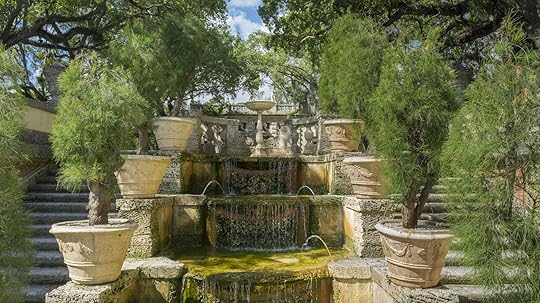
Photo: Robin Hill via Vizcaya Museum and Gardens
If you’ve seen pictures from a wedding at Vizcaya, chances are they were taken atop the Garden Mound. Grand limestone staircases lead to a shaded deck of live oaks and Spanish moss, where Biscayne Bay peeks between the trees. The view from the top looks out over the property’s lush gardens, and you’ll get your best photo ops up here.
4. The rooms of the first floorEach room on Vizcaya’s ground floor is decorated in a different style, from the Versailles-like Reception Room, to the stately English library and the Italian loggias that once served as outdoor patios. And each is a mini museum unto itself.
“If people are in a pinch, the main attractions are the large rooms and their intricate areas,” says Grey. “Going on a guided tour is helpful (to see those) and gives you an idea of what Vizcaya is all about.”
5. The Breakfast Room
Photo: Robin Hill via Vizcaya Museum and Gardens
In contrast to the rest of the home, which is done up in European design elements inspired by the grand mansions of France and Italy, the upstairs Breakfast Room is an immersion in Asian art. “The breakfast room is where (Deering) ate most of his meals,” says Grey. “And it has great views of the gardens.”
6. The Secret GardenThe Secret Garden isn’t really much of a “secret,” since seemingly every Quinceañeras picture in Miami is shot there. But its coral walls and elevated walkways make for the best “mini-tour” at Vizcaya, where photo ops under vine-covered arches and in limestone chairs abound. The garden was originally meant for orchids, but was replanted with succulents when orchid growing failed.
Three underrated areas you should visit at Vizcaya Museum and Gardens1. The Marine GardensDuring Vizcaya’s heyday, the property stretched south for 180 acres, and featured lagoon gardens where guests could step into a slice of natural Florida. Much of that property was sold off, but the Marine Gardens on the far south end still offer a bit of that feel, where mangroves, estuaries, and black-water ponds give the home a hint of the Everglades. “It gives you a look into what the gardens were like when this was a much bigger estate,” says Grey. “It’s a wild looking environment.”
2. The upstairs kitchen
Photo: Robin Hill via Vizcaya Museum and Gardens
Most grand old estates had kitchens either just off the main dining room or completely removed from the house. But not at Vizcaya, where the main kitchen sits upstairs, next to the breakfast room. It was a marvel of technology for its time, with electric refrigerators, butter molds, and automatic dumbwaiters. “Aesthetically, it’s very different from the rest of the house,” says Grey. “It’s very plain, but very grandiose at the same time.”
3. The orchidariumThis oft-overlooked garden sits on the north side of the house, directly across from the Vizcaya Café. It’s full of the colorful flowers that have become synonymous with Florida, and because the main house separates it from the other gardens, few visitors make it here. It’s the most calming and tranquil of all Vizcaya’s landscapes, and bursting with color most of the year.
What you can skip at Vizcaya Museum and GardensThe upstairs of the main house might seem alluring, but beyond Deering’s suite and the breakfast room and kitchen, there’s not a whole lot to see. The guest rooms are elegant, and a look at what bedrooms were 100 years ago. But if you’ve seen these sorts of rooms in historic homes before you don’t need to take time to see them.
Vizcaya hours and ticket pricesVizcaya is open every day except Tuesday, with the first admission at 9:30 AM and the last one at 4:30 PM. Once inside, you can stay in the main house until 5:00 PM and the gardens until 5:30 PM. Guided tours of the house run at 11:30 AM and 12:30 PM, and are $5 per person. Vizcaya also offers self-guided audio tours, available for no extra charge on Vizcaya’s app.
Admission for adults is $25, children six-12 are $10, and kids under six are free. Active duty military, military veterans, and people with disabilities are also free. 
Matador Network's Blog
- Matador Network's profile
- 6 followers



